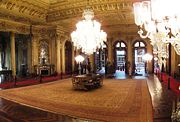
Hereke carpet
Encyclopedia


Hereke
Hereke is a town in Turkey, located near Istanbul. It is known for Hereke carpets. It was bounded to Gebze district until transferring to Körfez one in 1987 and had municipality until 2009. It consists from 17 Ağustos , Agah Ateş, Cumhuriyet, Haci Akif, Kışladüzü , Şirinyalı and Yukarı Hereke...
, a coastal town in Turkey
Turkey
Turkey , known officially as the Republic of Turkey , is a Eurasian country located in Western Asia and in East Thrace in Southeastern Europe...
, 60 km from Istanbul
Istanbul
Istanbul , historically known as Byzantium and Constantinople , is the largest city of Turkey. Istanbul metropolitan province had 13.26 million people living in it as of December, 2010, which is 18% of Turkey's population and the 3rd largest metropolitan area in Europe after London and...
. The materials used are silk
Silk
Silk is a natural protein fiber, some forms of which can be woven into textiles. The best-known type of silk is obtained from the cocoons of the larvae of the mulberry silkworm Bombyx mori reared in captivity...
, a combination of wool
Wool
Wool is the textile fiber obtained from sheep and certain other animals, including cashmere from goats, mohair from goats, qiviut from muskoxen, vicuña, alpaca, camel from animals in the camel family, and angora from rabbits....
and cotton
Cotton
Cotton is a soft, fluffy staple fiber that grows in a boll, or protective capsule, around the seeds of cotton plants of the genus Gossypium. The fiber is almost pure cellulose. The botanical purpose of cotton fiber is to aid in seed dispersal....
and sometimes gold or silver threads.
The Ottoman Sultan Abdülmecid I
Abdülmecid I
Sultan Abdülmecid I, Abdul Mejid I, Abd-ul-Mejid I or Abd Al-Majid I Ghazi was the 31st Sultan of the Ottoman Empire and succeeded his father Mahmud II on July 2, 1839. His reign was notable for the rise of nationalist movements within the empire's territories...
founded the Hereke Imperial Manufacture in 1841 to produce all the textiles for his Dolmabahçe Palace
Dolmabahçe Palace
Dolmabahçe Palace located in the Beşiktaş district of Istanbul, Turkey, on the European coastline of the Bosphorus strait, served as the main administrative center of the Ottoman Empire from 1856 to 1922, apart from a 22-year interval in which Yıldız Palace was used.- History :Dolmabahçe Palace...
on the Marmara Sea. He gathered the best artists and carpet weavers of the former Ottoman Empire
Ottoman Empire
The Ottoman EmpireIt was usually referred to as the "Ottoman Empire", the "Turkish Empire", the "Ottoman Caliphate" or more commonly "Turkey" by its contemporaries...
in Hereke, where they began producing high quality rugs and large carpets with unique patterns.
After completing work on the Dolmabahçe Palace, the Ottoman Sultans used to give Hereke carpets as gifts to selected visiting royalties, noblemen and statesmen. It was not until 1890 that some traders in Istanbul were allowed to sell some of the pieces made at Hereke. With the end of the Ottoman Empire the production of Hereke carpets was restricted until the middle of the 20th century when some master-weavers in Hereke began once more to produce the carpets in continuation of the tradition of the Ottoman Palace Carpets.
Hereke carpets typically are very large, palace sized carpets, and are made with wool on cotton, camel hair on cotton, silk on cotton as well as silk on silk, which are knotted in small sizes. The precision of their double knots (Turkish or Ghiordes knot
Ghiordes knot
The Ghiordes knot or Turkish knot is one of the two most-used knots employed in knotted-pile carpets. In the Ghiordes knot, the colored weft yarn passes over the two warp yarns, and is pulled through between them and then cut to form the pile...
s), which allows the clear display of patterns, together with the colour combinations and the harmonious patterns have made them highly collectible. Today, Hereke carpets and rugs are still made with the traditional patterns of the Ottoman Sultan Abdülmecid I, as well as both traditional Anatolian and contemporary figurative
Figurative art
Figurative art, sometimes written as figurativism, describes artwork—particularly paintings and sculptures—which are clearly derived from real object sources, and are therefore by definition representational.-Definition:...
patterns.
Literature
- M. Kenan Kaya (Sanat Tarihçisi M.A), Yaţar Yilmaz (Sanat Tarihçisi M. A), Sara Boynak (Tekstil Uzmani), Vahide Gezgör (Sanat Tarihçisi). Hereke Silk Carpets And Fabrics In the National Palaces Collection. TBMM, Istanbul.
- Oktay Aslanapa, Ayţe Fazlýođlu. The Last Loop of the Knot; Ottoman Court Carpets. TBMM, Istanbul, 2006.
- UgÌur Ayyildiz. Hereke and Kayseri: Pure silk Turkish carpets. NET Turizm Ticaret ve Sanayi A.S (1983). ASIN B0007B1NHG
- Önder Küçükerman. The rugs and textiles of Hereke: A documentary account of the history of Hereke : court workshop to model factory. Sümerbank Genel Müdürlüğü (1987). ASIN B0007BYPCQ

